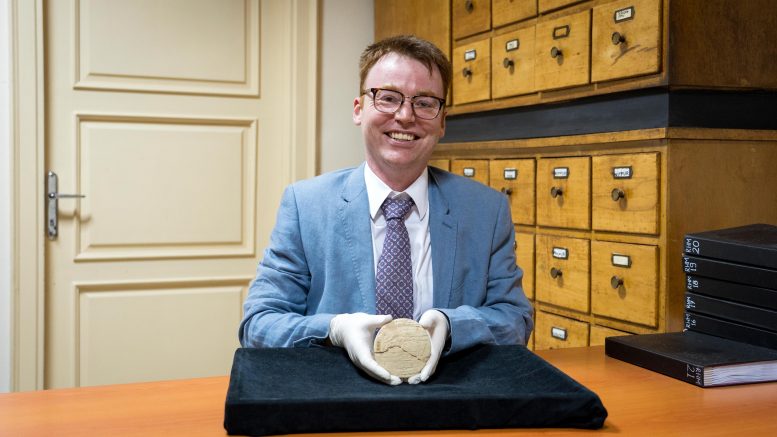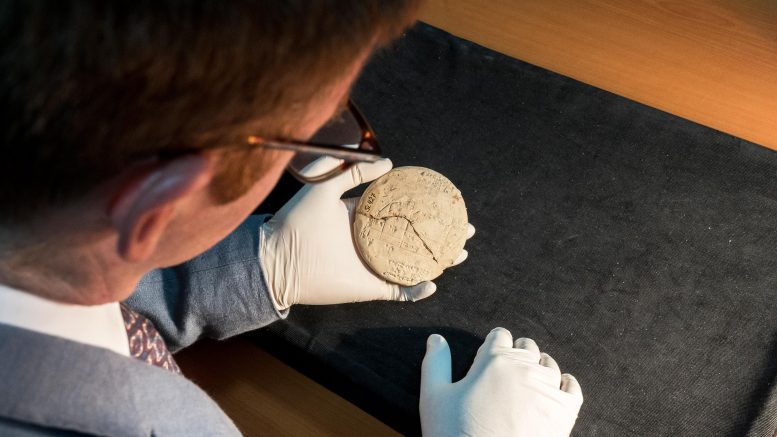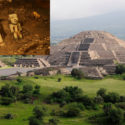3,700-Year-Old Clay Tablet Shows We’ve Been Using Geometry For Longer Than We Realized
Markings on a clay tablet manufactured in Babylon between 1900 and 1600 B.C.E. are the first known evidence of people utilizing applied geometry, according to a new study.
Officials in the Old Babylonian period utilized the item, known as Si.427, to demarcate property boundaries, according to Michelle Starr of Science Alert.
“In this case, it informs us legal and geometric facts about a field that’s split after a portion of it was auctioned off,” explains Daniel Mansfield, an Australian mathematician. Mansfield’s findings were just published in the journal Foundations of Science.

Si.427 makes mathematical computations based on accurate right angles using number sets now known as Pythagorean triples.
Pythagoras, an ancient Greek philosopher who used mathematics to discover geometric concepts, was born in 570 B.C., more than 1,000 years after the tablet was created.
“The Greeks invented trigonometry because they were studying astronomy,” Mansfield tells Vice’s Becky Ferreira, “but the Babylonians had their independent form of trigonometry that they developed to answer concerns like land and limits.”
According to Donna Lu of the Guardian, one side of the artifact has a diagram depicting rectangular fields with opposite sides of equal length.
The other is a cuneiform writing description of the country, which includes swampy areas, a threshing floor, and a nearby tower.
“Like we would today,” Mansfield tells the Guardian, “you’ve got private folks trying to figure out where their land boundaries are, and the surveyor comes out, but instead of utilizing GPS equipment, they use Pythagorean triples.”
Mansfield and colleague UNSW mathematician Norman Wildberger earlier discovered evidence that the first known representation of Pythagorean triples was found on a separate Old Babylonian tablet known as Plimpton 322.
According to a 2017 article in Discover magazine by Carl Engelking, the pair claimed the Babylonians utilized a base-60 method to calculate the lengths of the sides of a right triangle.
However, the researchers had no idea what the computations were for at the time. They theorized that the measurements were used in the construction of canals, palaces, and temples, as well as land surveying.

Si.427, a tablet discovered in 1894 in what is now Iraq, proved to be the key to the conundrum. As he describes for the Conversation, Mansfield discovered the clay relic at the Istanbul Archaeology Museums, where it had been mostly disregarded for decades.
“With this new tablet, we can finally see why they were interested in geometry in the first place: to set down accurate land boundaries,” Mansfield adds in the announcement. “This comes from a time when the property was beginning to become private—people began to conceive of land in terms of my land and your land,’ trying to set an appropriate boundary to have pleasant neighborly interactions.”
Other tablets from the same period add to our understanding of how individuals dealt with land ownership difficulties. A few of them refer to Sin-bel-apply. A conflict between Sin-bel-apply and a wealthy female landowner is described in one of the stories.
“Valuable date palms on the border between their two estates are at issue,” Mansfield said in the statement.
“To resolve the dispute, the local administrator agrees to send out a surveyor.” It’s easy to see how precision was critical in resolving disputes between such powerful people.”



